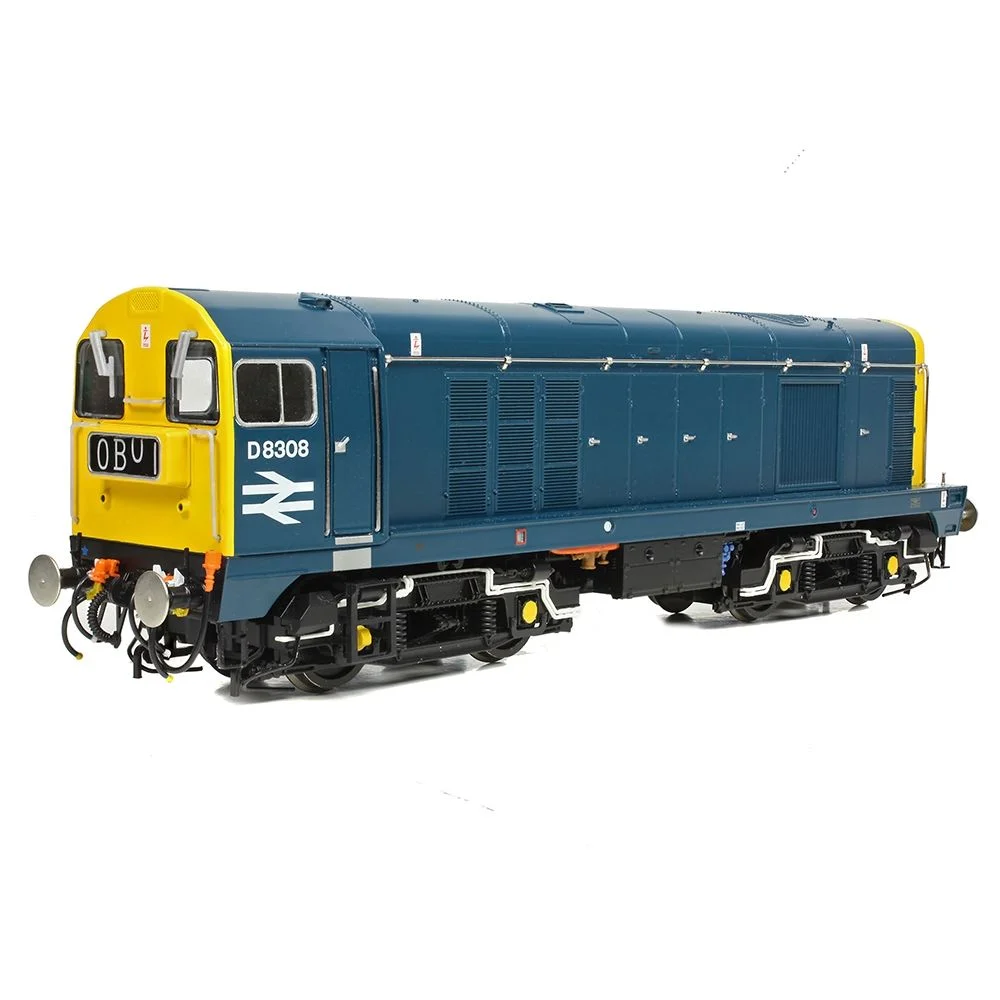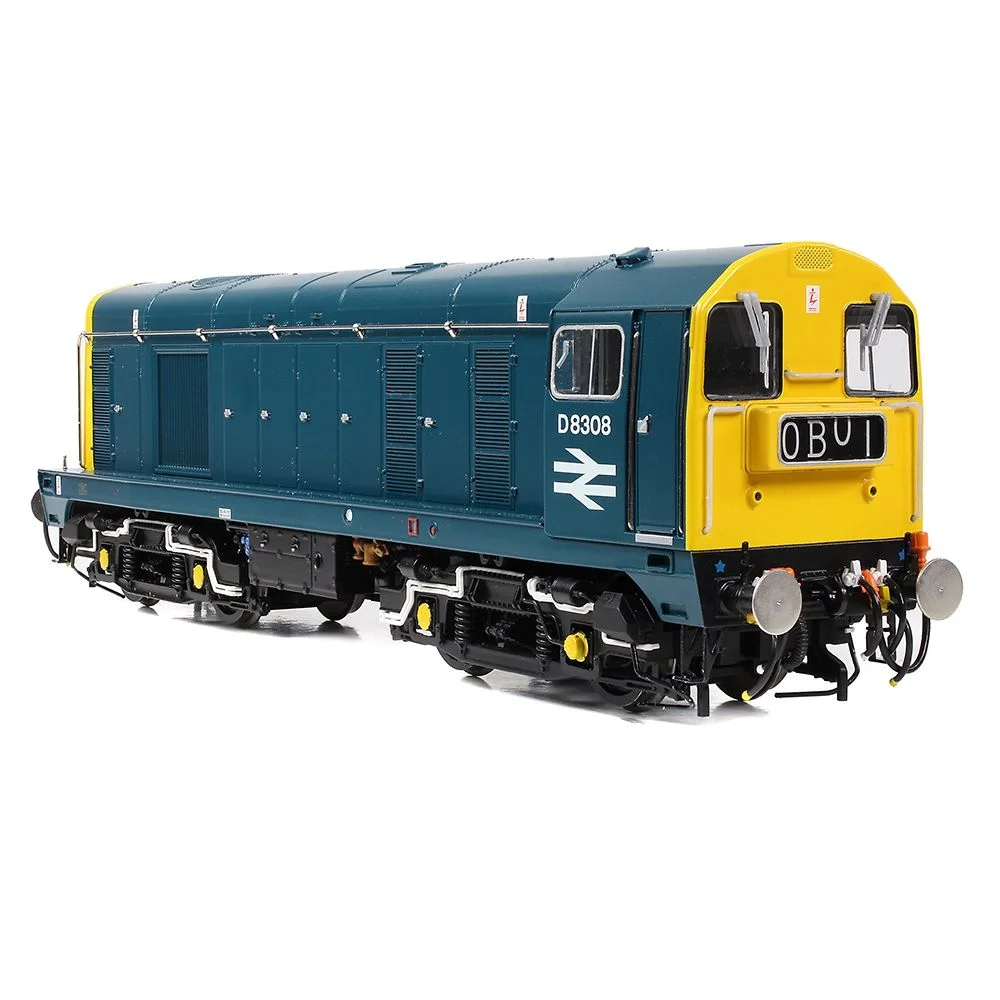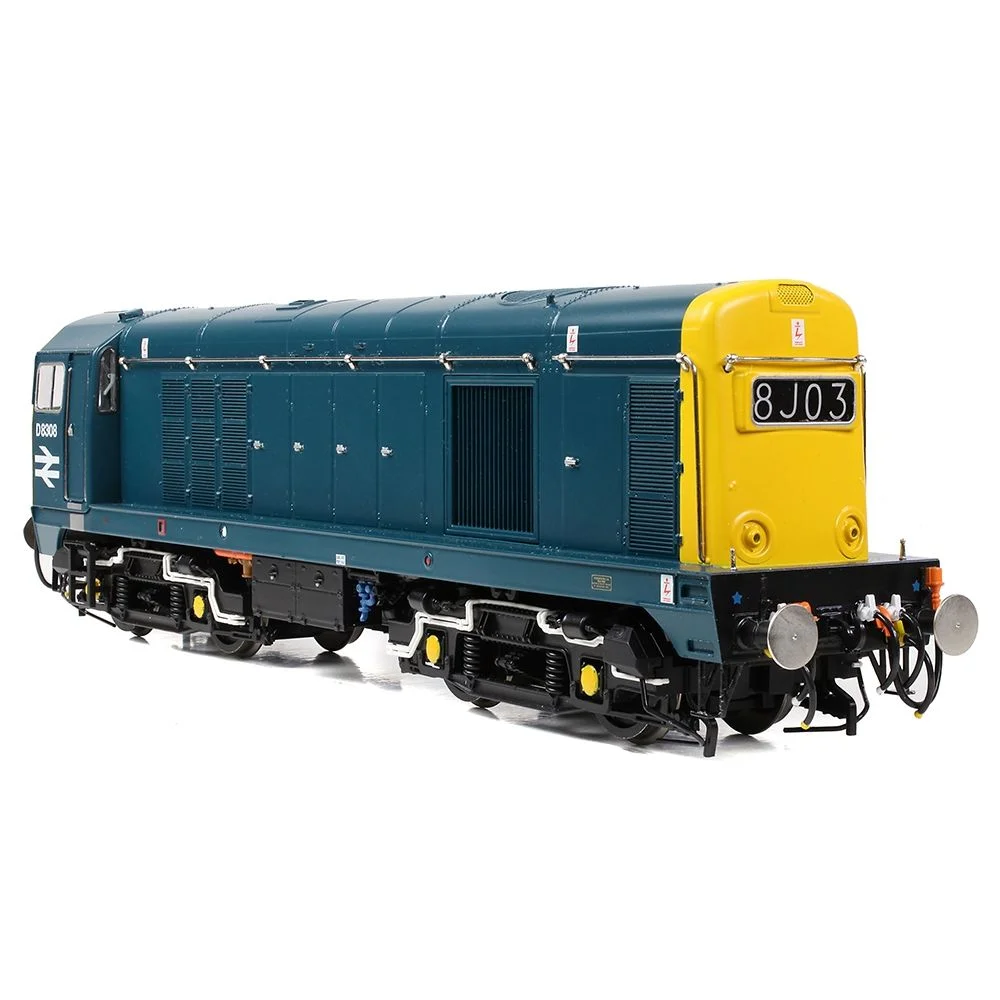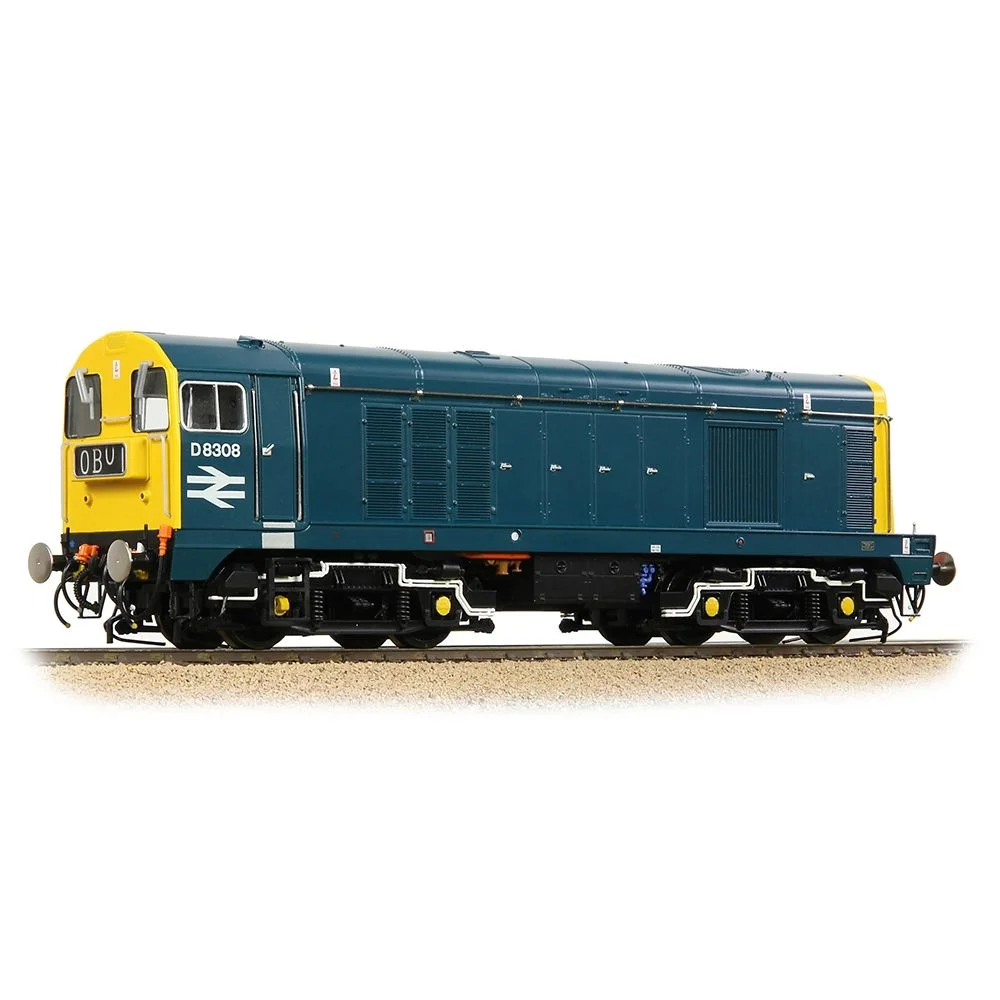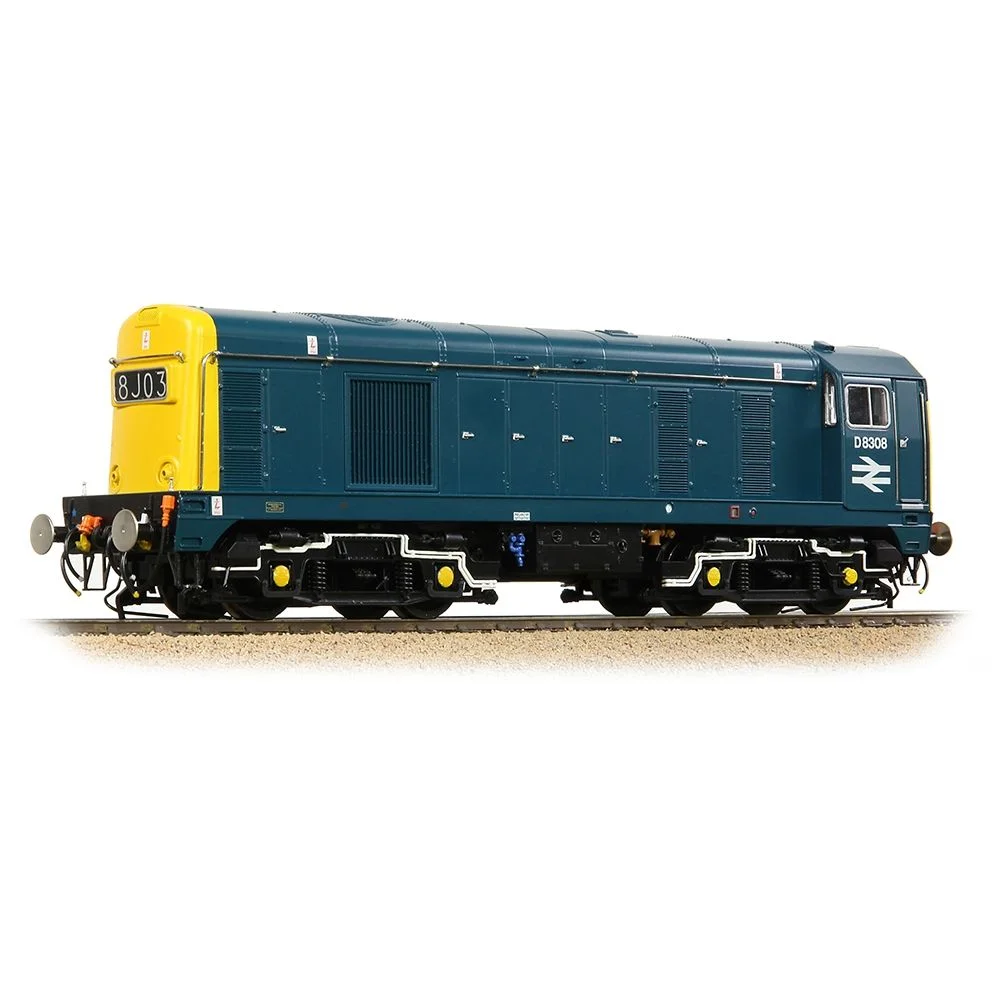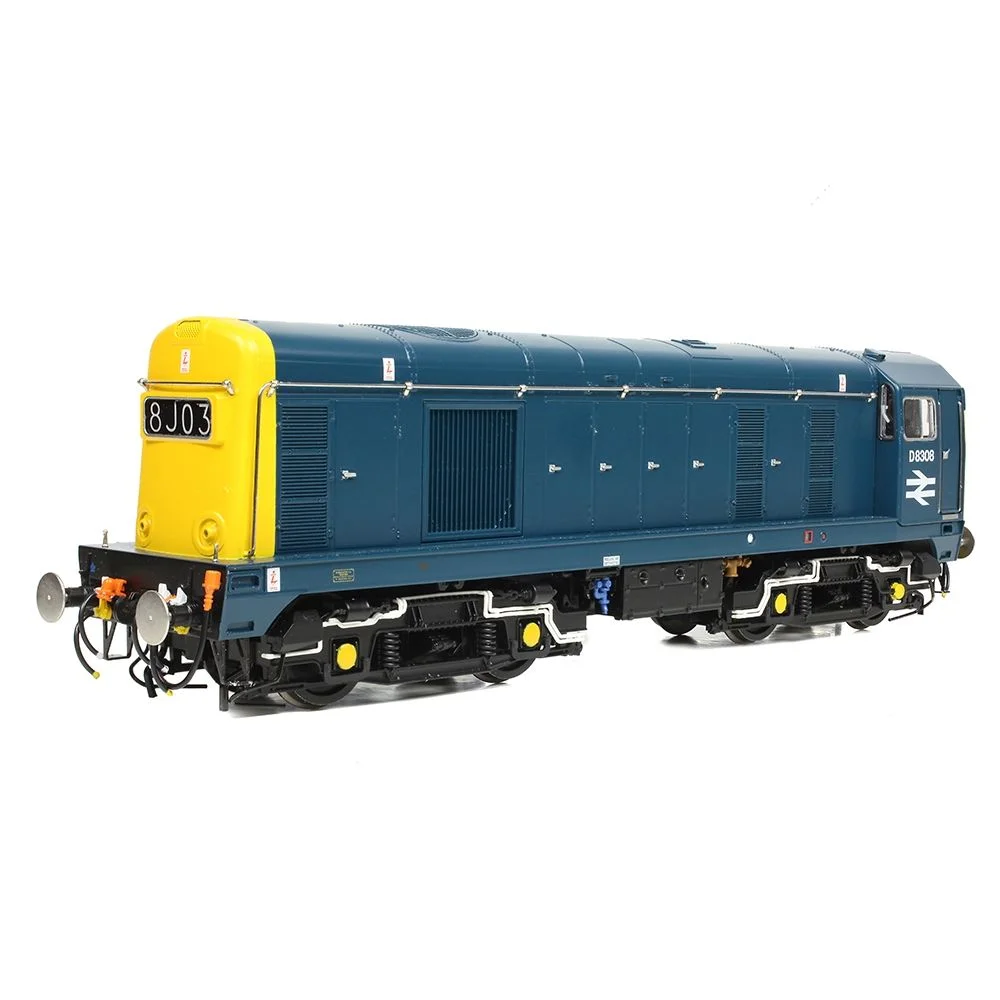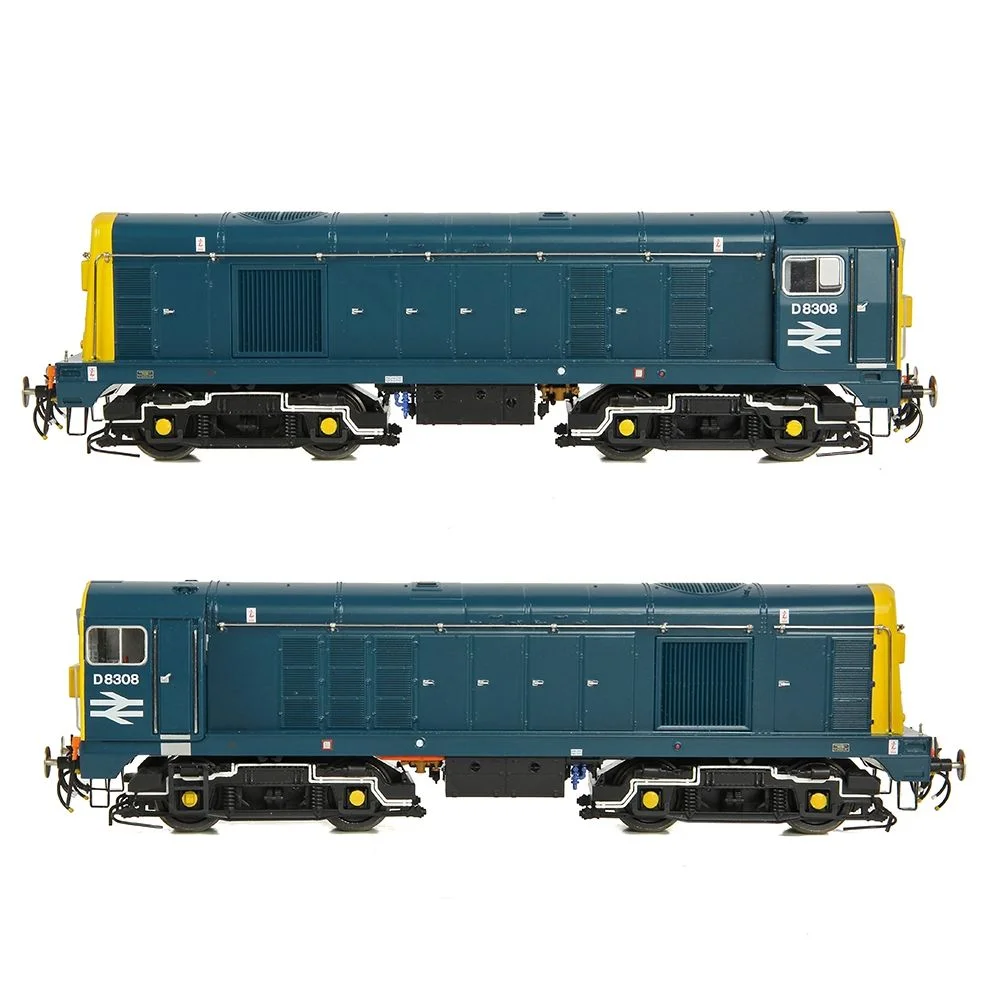Bachmann 35-359
British Rail Class 20/0 D8308 British Rail Blue
Tooling
In early 2021, Bachmann released a new Class 20 tooling aimed at representing the 20/3 variant. This update built upon the 2008 tooling, incorporating modern standards such as factory lighting and improved DCC integration while maintaining accurate body styling and finish.
Tooling Features
- Scale & Construction: OO gauge (1:76); plastic body shell over a diecast chassis.
- Detailing: Richly detailed etched grills, scale piping on bogies and bufferbeams, snowploughs included where appropriate, micro-style lamp irons, separately fitted handrails, and detailed cab interiors. Window wipers, battery boxes, sanders, footsteps, and finely moulded underframe eventuate realism and functional accuracy.
- Couplings: Tension-lock couplings in NEM pockets, with sprung buffers and accurate bogie equalising beams included.
Mechanical & Electrical
- Motor & Drive: Five-pole motor with flywheels, twin-shaft drive connecting to all axles, and comprehensive pick-up from each axle providing smooth and reliable running.
- Minimum Radius: Designed for a minimum Radius 2 curved track (~438 mm).
- Weighting: Diecast chassis provides ballast for strong traction.
- Lighting: Factory-fitted directional headlights at each end (warm/neutral LED), cab lighting available depending on variant.
- Assembly: Body attached to the chassis via screws, detailed extras supplied in accessory packs.
DCC Capability
This tooling marked a transition to a factory-fitted PluX22 decoder socket. The interface supports full feature decoders, including sound-ready decoders with space allocated for a small speaker or SugarCube-style speaker. Stay-alive capacitors can be easily fitted via the PluX interface for smooth digital running.
Liveries Produced
The 2021 tooling covers a wide variety of real-world schemes including:
- BR Green (Late Crest, Class 20/0)
- BR Blue (Headcode Box) and BR Blue with large logo
- Railfreight Grey (Red Stripe, Triple-Grey sectors)
- Direct Rail Services (plain, Compass blue)
- Harry Needle Railroad Company orange scheme
- London Transport maroon runs included as special runs
- Variants fitted as DCC ready or factory sound fitted
Reviews & Commentary
Model reviews highlighted the crisp new detailing such as etched grills, bogie and underframe added piping, and fully fitted lighting arrangements. Running tests praised the smooth low-speed performance, though minor cogging was occasionally mentioned. Sound-version models gained positive feedback for voice and engine realism, boosted by PluX22’s greater function control.
Media and Social Media
YouTube unboxings and review videos (e.g. Underground Eric, Sam’s Trains) showcased standout features: dual-end headlights, cab lighting, rich detailing, and the PluX22 interface. Enthusiasts praised the ease of decoder installation and speaker upgrades. Forum threads noted minor criticisms, such as bright LEDs on heritage liveries and missing headlamp surrounds in some variants.
Other Interesting Notes
- This tooling introduced the PluX22 socket as standard across Branchline diesels in anticipation of expanded lighting and sound functions.
- Factory-fitted cab lighting and speaker space were added in response to user demand for realistic operations.
- The tooling provided the baseline for later private-owner and special edition runs in 2022 and beyond.
Bachmann's Description & Specifications
- Bachmann Branchline OO Scale
- Era 6
- Pristine BR Blue livery
- Running No. D8308
- Equipped with a Plux22 DCC Decoder Socket – recommended Decoder item No. 36-570A
- Length 190mm
DETAIL VARIATIONS SPECIFIC TO THIS MODEL
- Headcode Boxes
- Small Cab Side Windows
- One Piece Radiator Shutter
- Two Piece Bodyside Handrail (RHS)
- Bodyside Ladder (optional part supplied in the Accessory Pack)
- Late Fluted Bogie Equalising Beams
- Electrical Speedo Drive
- Original Battery Boxes
- Two Sandboxes per Bogie
- Round Oleo Buffers
- Buffer Tube Lamp Brackets
- Scottish-Style Bufferbeam
- Chassis Inspection Light Socket
- Nose-end Solebar Handles
- Snowploughs (optional part supplied in the Accessory Pack)
MECHANISM:
- Five pole, twin shaft motor with two flywheels providing drive to both bogies
- All axle drive
- Electrical pickup from all wheels
- Separate metal bearings fitted to each axle
- Diecast metal chassis block and bogie towers
- Diecast metal gearboxes, with gearing arranged for prototypical running speeds and haulage capabilities
- 5mm (OO gauge) wheels to NEM310 & NEM311 standards with authentic profile and detailing
- Detachable coupling pockets to NEM362 standards fitted to each bogie
- Designed to operate on curves of second radius (438mm) or greater
DETAILING:
- Bogies constructed from multiple components featuring full relief detail
- Rotating radiator fan (un-motorised)
- Separately applied metal detail parts, including handrails, grab handles, sand pipes and etched fan grilles
- Sprung metal buffers
- Body-mounted snow ploughs supplied with each model
- Each model supplied with a full set of decorated, model-specific bufferbeam pipework and accessory parts
LIGHTING:
- Directional lighting, switchable on/off at either end on DCC or Analogue control
- Day/Night Mode, selectable on DCC or Analogue control
- Cab lighting, switchable on/off on DCC or Analogue control
- Authentic light colours and temperatures selected for each model based on era and application
DCC:
- Plux22 DCC decoder interface
SOUND:
- Speaker installed in all models for optimum sound reproduction
- Zimo MS450P22 DCC Sound Decoder fitted to SOUND FITTED versions
- Sound files produced specifically for the Bachmann Branchline Class 20 using recordings from real locomotives
- SOUND FITTED models operate on DCC and Analogue control as supplied. On Analogue, an authentic engine start up sequence and running sounds are produced when power is applied
LIVERY APPLICATION:
- Authentic liveries applied to all models
- Multiple paint applications employed on each model using BR and corporate specification colours
- Logos, numerals and text added as appropriate using multi-stage tampo printing using authentic typefaces, logos and colours
- In addition, where applicable Etched Nameplates and Plaques are also provided
Class & Prototype
- Class: British Rail Class 20/0
- Traction: Diesel
- Transmission: Electric
- Built: 1957-1968
- Total Built: -
The BR Class 20 (English Electric Type 1) served British railways from 1957-2025 as one of the most successful diesel designs ever built. With 228 locomotives constructed 1957-1968, these distinctive single-cab "hood units" became famous for their reliable English Electric 8SVT 1,000 hp engines, characteristic nose-to-nose paired operation, and beloved "Chopper" exhaust sound. They worked cross-London freights, Yorkshire coal trains, MGR operations, and modern nuclear flask services. Outstanding models available from Bachmann (OO), Graham Farish (N), and Heljan (O) in liveries from BR Green through DRS Blue.
No prototype found.
Operator & Livery
- Operator: British Rail
- Livery: Blue
British Rail (1965-1997) transformed Britain's railways through revolutionary modernisation, introducing the iconic double arrow logo, Rail Blue livery, and business sectorisation. BR pioneered high-speed rail with the InterCity 125 and Advanced Passenger Train, electrified major routes, and created profitable divisions like InterCity and Network SouthEast. From steam succession through diesel and electric development to privatisation preparation, British Rail's diverse locomotive fleet, multiple livery schemes, and operational scenarios provide unparalleled variety for railway modellers across all scales and periods.
BR Blue, also known as Rail Blue or Monastral Blue, was introduced in 1965 as part of British Rail's comprehensive corporate identity overhaul that accompanied the rebranding from British Railways to British Rail. The colour was officially defined by British Standards BR28/6001 (airless spray finish) and BR28/5321 (brush finish), representing a dark, greyish blue tone specifically chosen to hide dirt and weathering effects well.
The livery was prototyped on the experimental XP64 train in 1964 before becoming the standard scheme from 1 January 1965. Rail Blue was applied to all diesel and electric locomotives with yellow warning panels (initially small, then extending to full yellow ends from 1966). The standardised application included the iconic double arrow logo and Rail Alphabet typeface, creating one of the most successful transport corporate identities of the 20th century.
The livery dominated British Rail operations for over two decades until sectorisation in the 1980s began fragmenting the unified appearance. Despite initial colour fading problems in early applications, these were resolved by the late 1970s when the Large Logo variant was introduced featuring extended yellow areas and full-height double arrow symbols. Rail Blue's enduring appeal among railway enthusiasts reflects its role as the definitive British Rail image during the organisation's most unified period.
